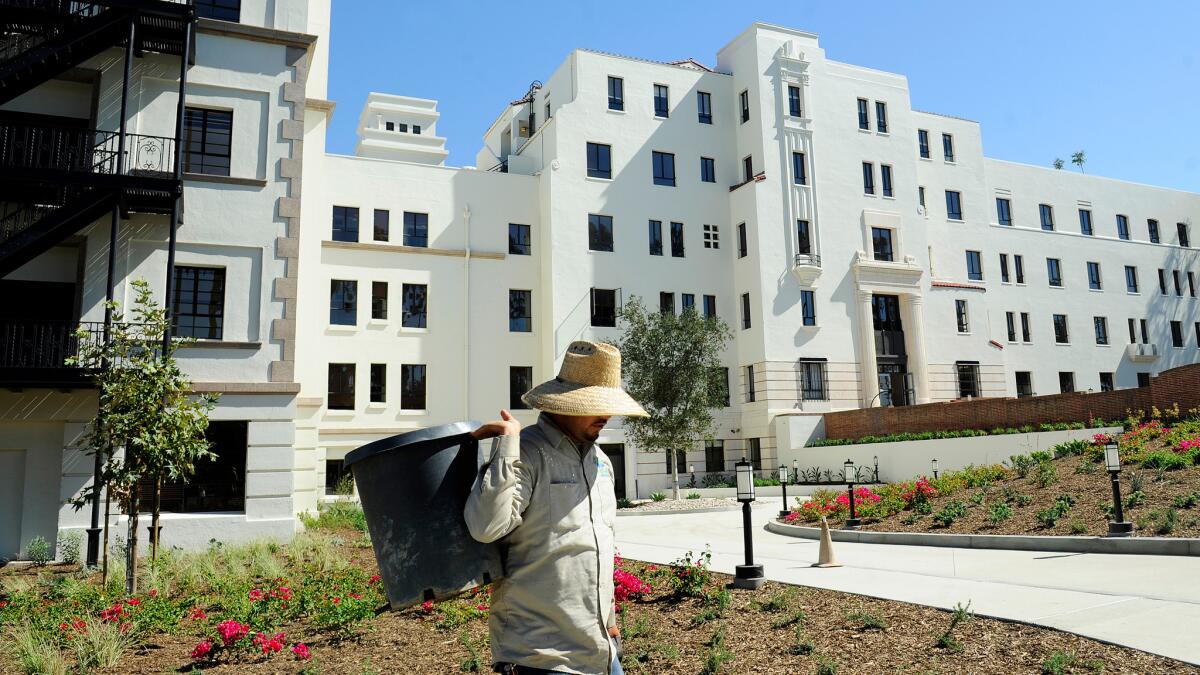White communities in the Bay Area have lower low-income housing goals, study finds

California communities with large white populations aren’t planning for their fair share of low- and moderate-income housing growth, according to a new study of Bay Area cities.
Every eight years, a state law requires cities to plan for a certain amount of new homes to keep pace with projected population growth for people of various incomes. The study by UC Berkeley’s Haas Institute for a Fair and Inclusive Society found that Bay Area cities that have higher percentages of white residents had lower home building goals for low- and middle-income Californians.
“You’re getting what appears to be whiter areas shirking their responsibility,” said Eli Moore, one of the study’s authors.
The state sets housing production goals by sending population growth estimates to 19 regional agencies, including the Assn. of Bay Area Governments and the Southern California Assn. of Governments in the Los Angeles area. These agencies tell cities and counties how many homes are needed by income level, and local governments have to zone enough land to accommodate the new home building. The state then signs off on these plans.
The UC Berkeley report found that for the current goals to build in the Bay Area through through 2023, cities with larger shares of white residents had lower targets to house residents of lower incomes than those with larger black, Latino and Asian populations.
The racial disparities remained even when taking into account a city’s population and income. For instance, Marin County’s Larkspur, which is more than 80% white, has a goal of building 81 homes for low- and moderate-income earners, while the target for Contra Costa County’s Pinole, which is 37% white, is 171 such homes even though the two cities are about the same size and their residents earn similar salaries.
The study’s publication comes as state lawmakers debate a package of legislation designed to tackle California’s housing affordability crisis. One bill would require cities that have fallen behind on meeting their housing goals to ease home building regulations. But the study’s authors say lawmakers need to go further and consider racial equity when setting the targets.
A measure that would have addressed that issue is on hold. Assemblyman Miguel Santiago (D-Los Angeles) wrote a bill that would push cities and counties to reverse the effects of previous federal, state and local policies, such as building white-only public housing projects and providing loans to developers only if they barred black residents, that led to segregation. Under Santiago’s legislation, local governments would have to strip away zoning restrictions and other barriers to low-income housing development, particularly in neighborhoods where there isn’t any.
“It’s not enough to not discriminate,” Santiago said. “We have to work at unwinding systematic discrimination that we’ve seen in urban planning over decades.”
Santiago, who grew up in subsidized housing in the San Fernando Valley, said the motivation for his legislation was indications that the Trump administration would undo Obama-era regulations requiring cities to promote integration. Santiago said he wanted to work with local governments opposed to his bill to ensure they could comply with its mandates. He plans to renew his efforts in 2018, and said UC Berkeley’s findings add to the need for state intervention.
The study did not find racial disparities when Bay Area cities permitted the construction of low-income housing. The disparities also didn’t exist under the Bay Area’s previous goals for low-income development, including those covering 2007 to 2014. The current housing targets are the first to be set under new rules designed to help the state meet its goals for greenhouse gas reduction by encouraging more construction near transit lines and job centers. Moore, the study’s author, said the findings imply that cities in the Bay Area with larger white populations did not want such development.
“It not only falls short of the goals of sustainable planning,” Moore said, “it also perpetuates racial and income segregation.”
Twitter: @dillonliam
ALSO
A Bay Area developer wants to build 4,400 sorely needed homes. Here’s why it won’t happen
Bay Area freeways average one car-to-car shooting every week, CHP data show
California Assembly Speaker: Housing spending this year is more important than water and parks
State Senate bills aim to make homes more affordable, but they won’t spur nearly enough construction
Updates on California politics
More to Read
Get the L.A. Times Politics newsletter
Deeply reported insights into legislation, politics and policy from Sacramento, Washington and beyond. In your inbox three times per week.
You may occasionally receive promotional content from the Los Angeles Times.







